Effective Nurse-Patient Communication for Therapeutic Relationships
VerifiedAdded on 2022/09/18
|8
|1666
|24
Essay
AI Summary
This essay explores the critical role of effective nurse-patient communication in standard nursing practice, emphasizing its importance for high-quality, patient-centered care and patient safety. It delves into the significance of both verbal and non-verbal communication modes, highlighting their application in fostering therapeutic relationships, as demonstrated in a case study of a 73-year-old patient, George Pham. The essay discusses how nurses can utilize these communication tools to assess patients' needs, build trust, and develop personalized care plans. Furthermore, it underscores the importance of patient-centered care, ensuring that the unique requirements of each patient are addressed, thereby promoting safety and positive health outcomes. The essay also examines the role of effective documentation in maintaining accurate records of patient health, history, and lifestyle, which is essential for creating safe and tailored care plans. By analyzing these components, the essay concludes that effective communication is fundamental for optimal nursing practice, patient well-being, and the development of strong nurse-patient relationships.
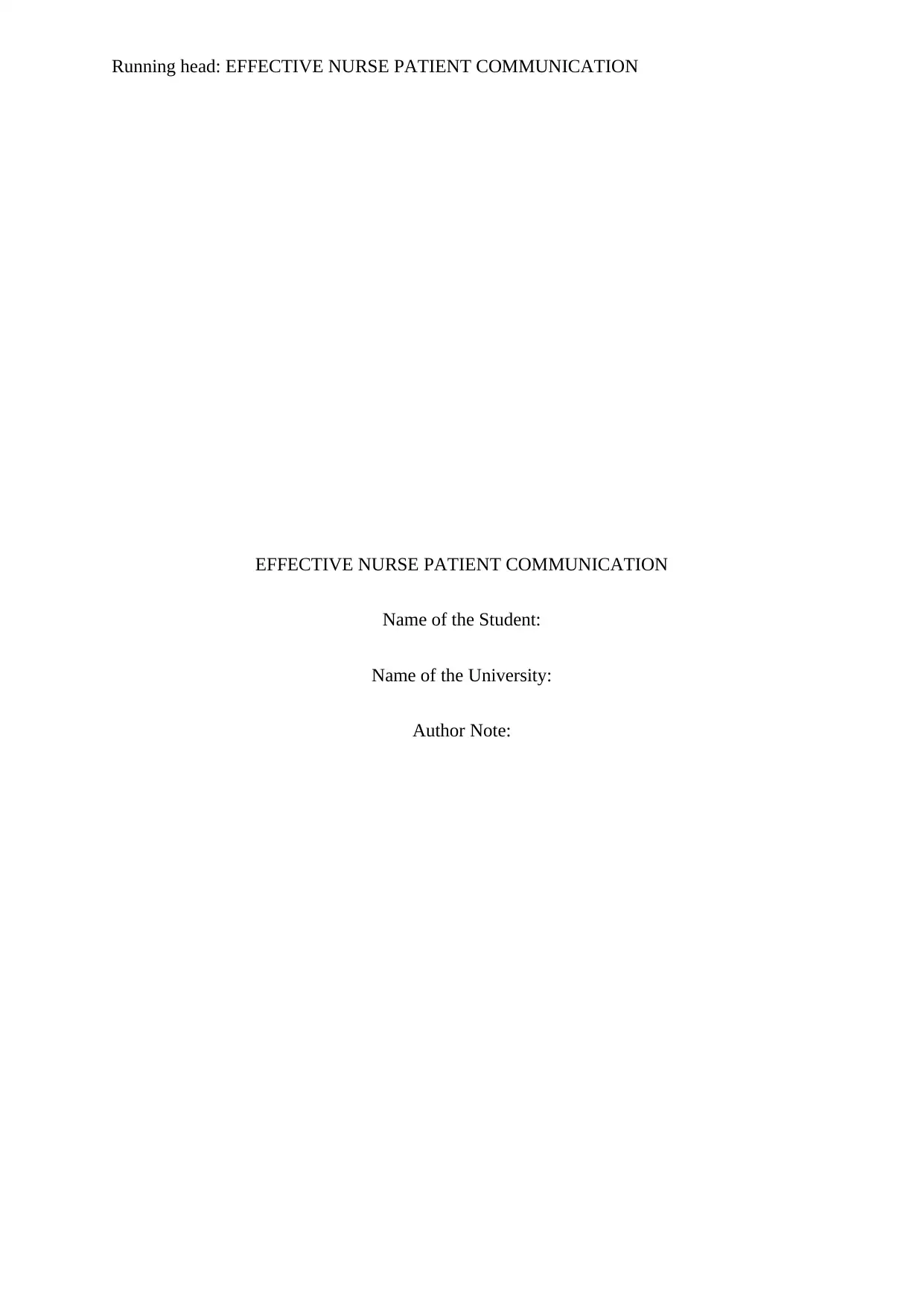
Running head: EFFECTIVE NURSE PATIENT COMMUNICATION
EFFECTIVE NURSE PATIENT COMMUNICATION
Name of the Student:
Name of the University:
Author Note:
EFFECTIVE NURSE PATIENT COMMUNICATION
Name of the Student:
Name of the University:
Author Note:
Paraphrase This Document
Need a fresh take? Get an instant paraphrase of this document with our AI Paraphraser
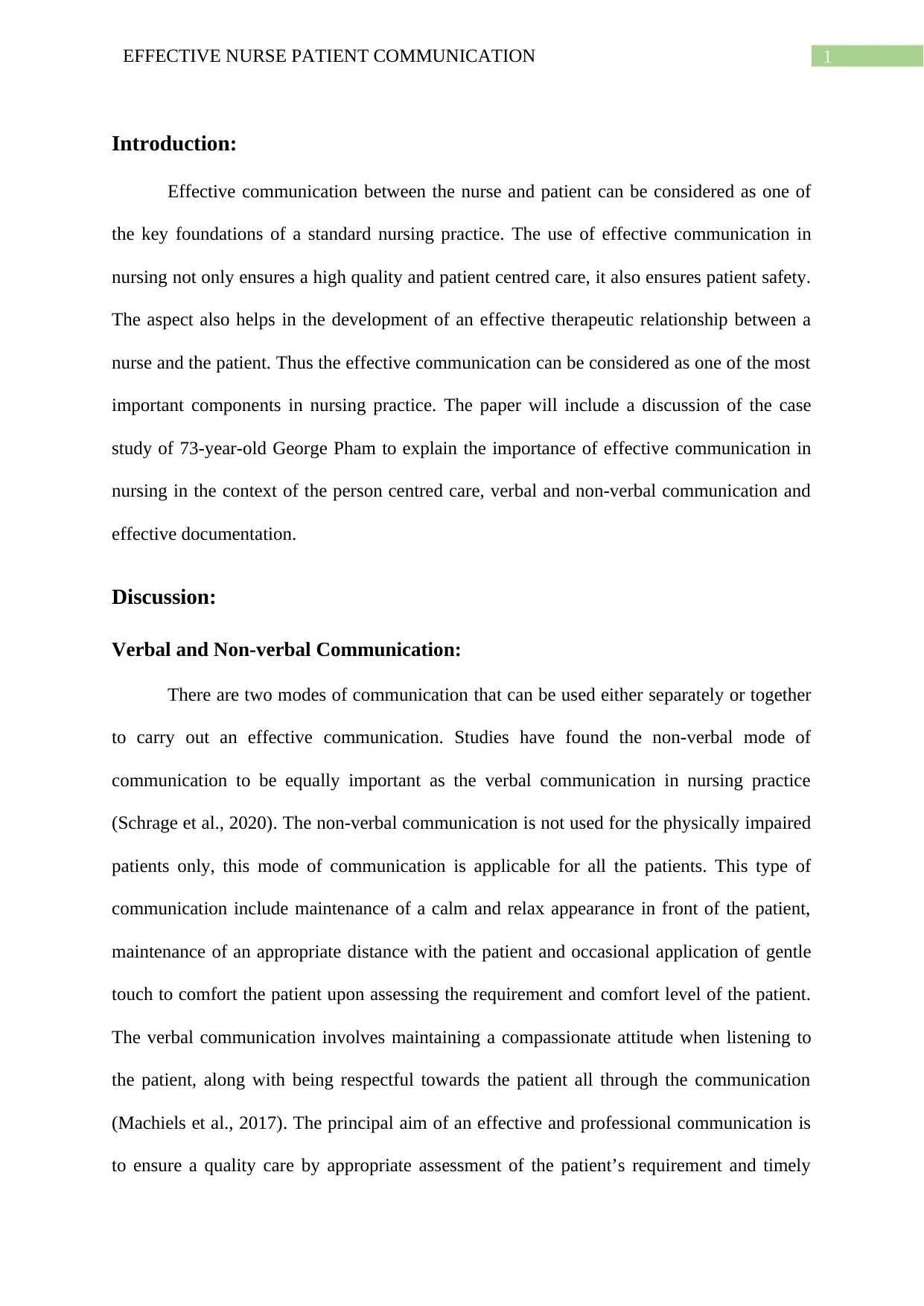
1EFFECTIVE NURSE PATIENT COMMUNICATION
Introduction:
Effective communication between the nurse and patient can be considered as one of
the key foundations of a standard nursing practice. The use of effective communication in
nursing not only ensures a high quality and patient centred care, it also ensures patient safety.
The aspect also helps in the development of an effective therapeutic relationship between a
nurse and the patient. Thus the effective communication can be considered as one of the most
important components in nursing practice. The paper will include a discussion of the case
study of 73-year-old George Pham to explain the importance of effective communication in
nursing in the context of the person centred care, verbal and non-verbal communication and
effective documentation.
Discussion:
Verbal and Non-verbal Communication:
There are two modes of communication that can be used either separately or together
to carry out an effective communication. Studies have found the non-verbal mode of
communication to be equally important as the verbal communication in nursing practice
(Schrage et al., 2020). The non-verbal communication is not used for the physically impaired
patients only, this mode of communication is applicable for all the patients. This type of
communication include maintenance of a calm and relax appearance in front of the patient,
maintenance of an appropriate distance with the patient and occasional application of gentle
touch to comfort the patient upon assessing the requirement and comfort level of the patient.
The verbal communication involves maintaining a compassionate attitude when listening to
the patient, along with being respectful towards the patient all through the communication
(Machiels et al., 2017). The principal aim of an effective and professional communication is
to ensure a quality care by appropriate assessment of the patient’s requirement and timely
Introduction:
Effective communication between the nurse and patient can be considered as one of
the key foundations of a standard nursing practice. The use of effective communication in
nursing not only ensures a high quality and patient centred care, it also ensures patient safety.
The aspect also helps in the development of an effective therapeutic relationship between a
nurse and the patient. Thus the effective communication can be considered as one of the most
important components in nursing practice. The paper will include a discussion of the case
study of 73-year-old George Pham to explain the importance of effective communication in
nursing in the context of the person centred care, verbal and non-verbal communication and
effective documentation.
Discussion:
Verbal and Non-verbal Communication:
There are two modes of communication that can be used either separately or together
to carry out an effective communication. Studies have found the non-verbal mode of
communication to be equally important as the verbal communication in nursing practice
(Schrage et al., 2020). The non-verbal communication is not used for the physically impaired
patients only, this mode of communication is applicable for all the patients. This type of
communication include maintenance of a calm and relax appearance in front of the patient,
maintenance of an appropriate distance with the patient and occasional application of gentle
touch to comfort the patient upon assessing the requirement and comfort level of the patient.
The verbal communication involves maintaining a compassionate attitude when listening to
the patient, along with being respectful towards the patient all through the communication
(Machiels et al., 2017). The principal aim of an effective and professional communication is
to ensure a quality care by appropriate assessment of the patient’s requirement and timely
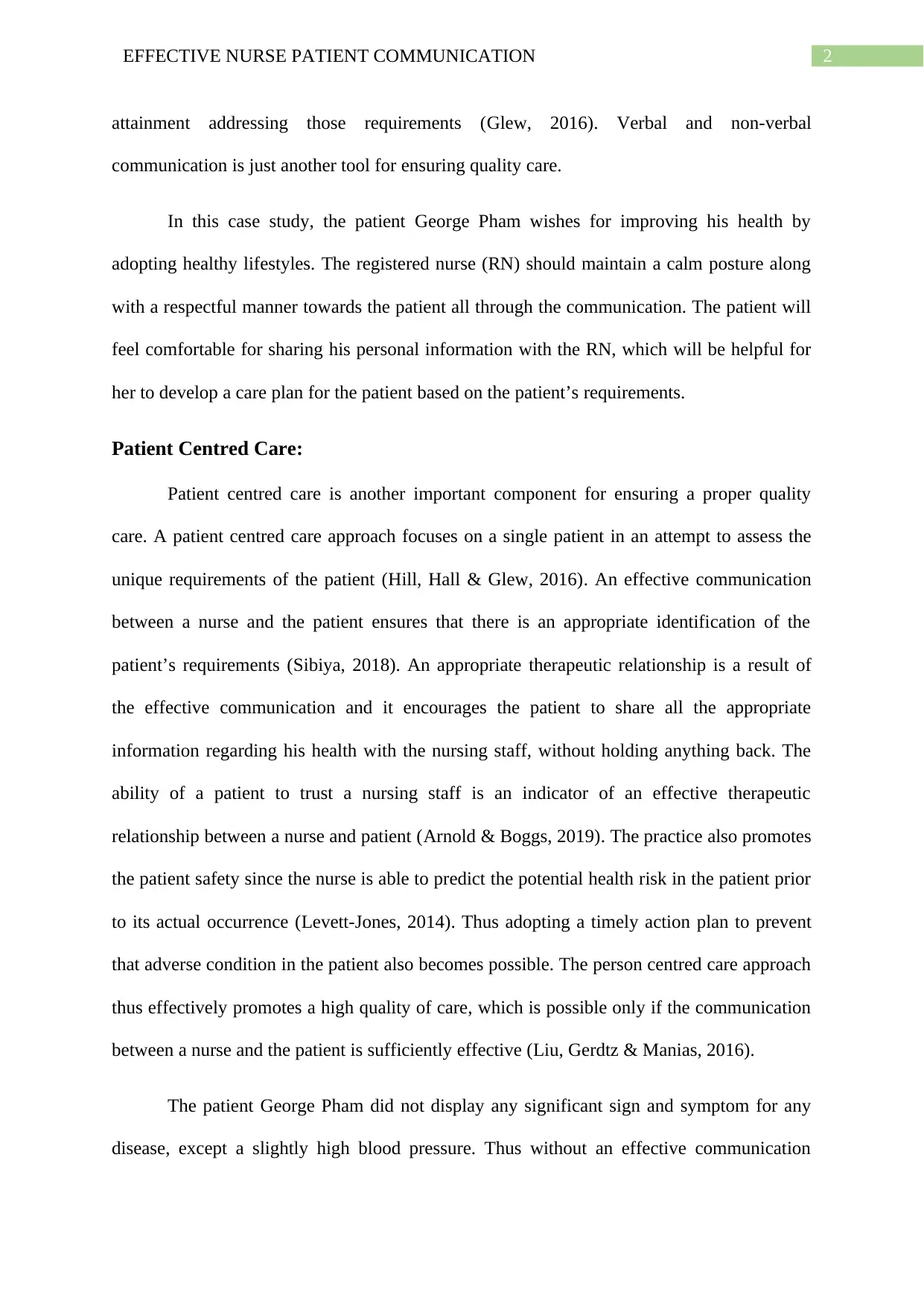
2EFFECTIVE NURSE PATIENT COMMUNICATION
attainment addressing those requirements (Glew, 2016). Verbal and non-verbal
communication is just another tool for ensuring quality care.
In this case study, the patient George Pham wishes for improving his health by
adopting healthy lifestyles. The registered nurse (RN) should maintain a calm posture along
with a respectful manner towards the patient all through the communication. The patient will
feel comfortable for sharing his personal information with the RN, which will be helpful for
her to develop a care plan for the patient based on the patient’s requirements.
Patient Centred Care:
Patient centred care is another important component for ensuring a proper quality
care. A patient centred care approach focuses on a single patient in an attempt to assess the
unique requirements of the patient (Hill, Hall & Glew, 2016). An effective communication
between a nurse and the patient ensures that there is an appropriate identification of the
patient’s requirements (Sibiya, 2018). An appropriate therapeutic relationship is a result of
the effective communication and it encourages the patient to share all the appropriate
information regarding his health with the nursing staff, without holding anything back. The
ability of a patient to trust a nursing staff is an indicator of an effective therapeutic
relationship between a nurse and patient (Arnold & Boggs, 2019). The practice also promotes
the patient safety since the nurse is able to predict the potential health risk in the patient prior
to its actual occurrence (Levett-Jones, 2014). Thus adopting a timely action plan to prevent
that adverse condition in the patient also becomes possible. The person centred care approach
thus effectively promotes a high quality of care, which is possible only if the communication
between a nurse and the patient is sufficiently effective (Liu, Gerdtz & Manias, 2016).
The patient George Pham did not display any significant sign and symptom for any
disease, except a slightly high blood pressure. Thus without an effective communication
attainment addressing those requirements (Glew, 2016). Verbal and non-verbal
communication is just another tool for ensuring quality care.
In this case study, the patient George Pham wishes for improving his health by
adopting healthy lifestyles. The registered nurse (RN) should maintain a calm posture along
with a respectful manner towards the patient all through the communication. The patient will
feel comfortable for sharing his personal information with the RN, which will be helpful for
her to develop a care plan for the patient based on the patient’s requirements.
Patient Centred Care:
Patient centred care is another important component for ensuring a proper quality
care. A patient centred care approach focuses on a single patient in an attempt to assess the
unique requirements of the patient (Hill, Hall & Glew, 2016). An effective communication
between a nurse and the patient ensures that there is an appropriate identification of the
patient’s requirements (Sibiya, 2018). An appropriate therapeutic relationship is a result of
the effective communication and it encourages the patient to share all the appropriate
information regarding his health with the nursing staff, without holding anything back. The
ability of a patient to trust a nursing staff is an indicator of an effective therapeutic
relationship between a nurse and patient (Arnold & Boggs, 2019). The practice also promotes
the patient safety since the nurse is able to predict the potential health risk in the patient prior
to its actual occurrence (Levett-Jones, 2014). Thus adopting a timely action plan to prevent
that adverse condition in the patient also becomes possible. The person centred care approach
thus effectively promotes a high quality of care, which is possible only if the communication
between a nurse and the patient is sufficiently effective (Liu, Gerdtz & Manias, 2016).
The patient George Pham did not display any significant sign and symptom for any
disease, except a slightly high blood pressure. Thus without an effective communication
⊘ This is a preview!⊘
Do you want full access?
Subscribe today to unlock all pages.

Trusted by 1+ million students worldwide
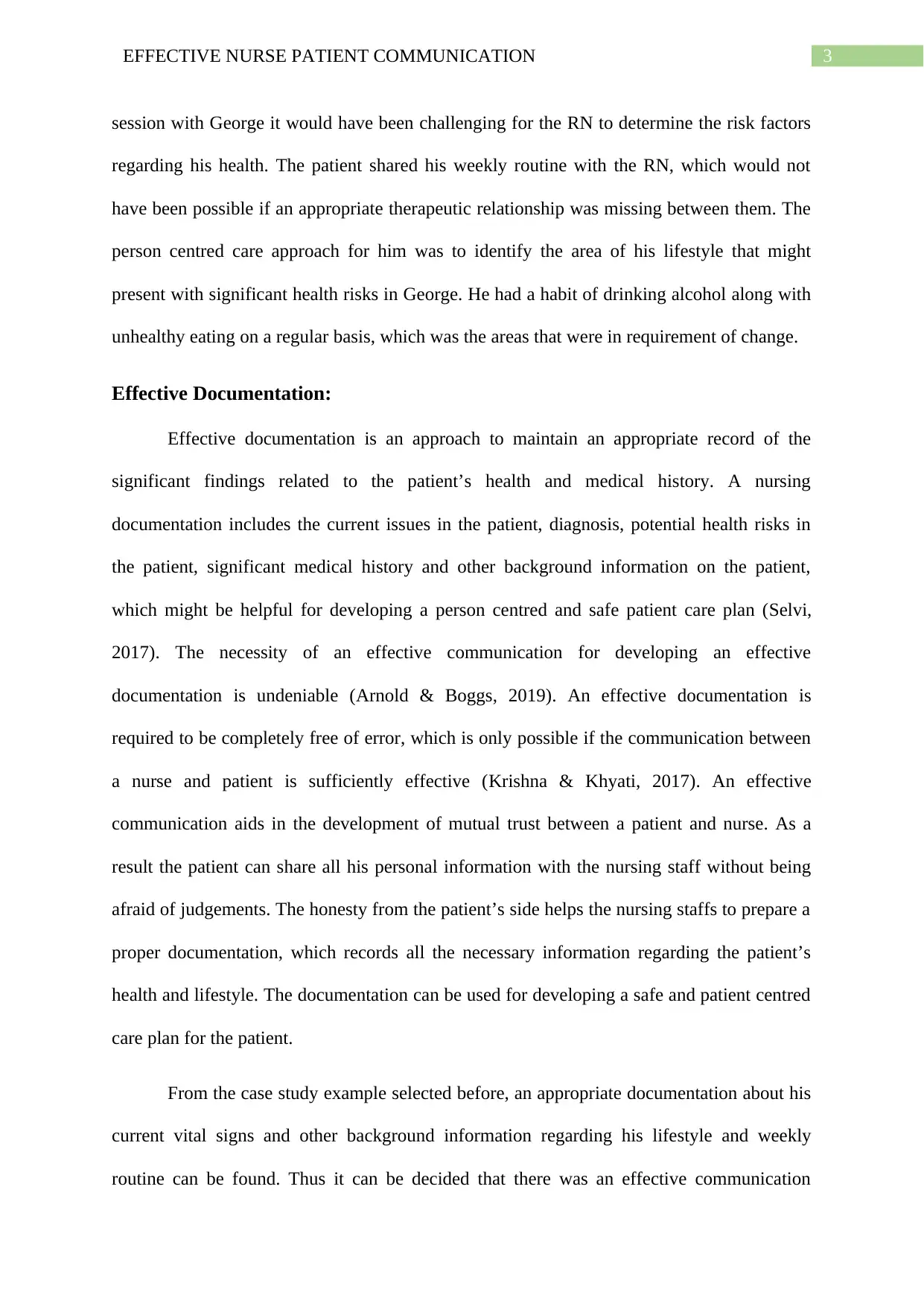
3EFFECTIVE NURSE PATIENT COMMUNICATION
session with George it would have been challenging for the RN to determine the risk factors
regarding his health. The patient shared his weekly routine with the RN, which would not
have been possible if an appropriate therapeutic relationship was missing between them. The
person centred care approach for him was to identify the area of his lifestyle that might
present with significant health risks in George. He had a habit of drinking alcohol along with
unhealthy eating on a regular basis, which was the areas that were in requirement of change.
Effective Documentation:
Effective documentation is an approach to maintain an appropriate record of the
significant findings related to the patient’s health and medical history. A nursing
documentation includes the current issues in the patient, diagnosis, potential health risks in
the patient, significant medical history and other background information on the patient,
which might be helpful for developing a person centred and safe patient care plan (Selvi,
2017). The necessity of an effective communication for developing an effective
documentation is undeniable (Arnold & Boggs, 2019). An effective documentation is
required to be completely free of error, which is only possible if the communication between
a nurse and patient is sufficiently effective (Krishna & Khyati, 2017). An effective
communication aids in the development of mutual trust between a patient and nurse. As a
result the patient can share all his personal information with the nursing staff without being
afraid of judgements. The honesty from the patient’s side helps the nursing staffs to prepare a
proper documentation, which records all the necessary information regarding the patient’s
health and lifestyle. The documentation can be used for developing a safe and patient centred
care plan for the patient.
From the case study example selected before, an appropriate documentation about his
current vital signs and other background information regarding his lifestyle and weekly
routine can be found. Thus it can be decided that there was an effective communication
session with George it would have been challenging for the RN to determine the risk factors
regarding his health. The patient shared his weekly routine with the RN, which would not
have been possible if an appropriate therapeutic relationship was missing between them. The
person centred care approach for him was to identify the area of his lifestyle that might
present with significant health risks in George. He had a habit of drinking alcohol along with
unhealthy eating on a regular basis, which was the areas that were in requirement of change.
Effective Documentation:
Effective documentation is an approach to maintain an appropriate record of the
significant findings related to the patient’s health and medical history. A nursing
documentation includes the current issues in the patient, diagnosis, potential health risks in
the patient, significant medical history and other background information on the patient,
which might be helpful for developing a person centred and safe patient care plan (Selvi,
2017). The necessity of an effective communication for developing an effective
documentation is undeniable (Arnold & Boggs, 2019). An effective documentation is
required to be completely free of error, which is only possible if the communication between
a nurse and patient is sufficiently effective (Krishna & Khyati, 2017). An effective
communication aids in the development of mutual trust between a patient and nurse. As a
result the patient can share all his personal information with the nursing staff without being
afraid of judgements. The honesty from the patient’s side helps the nursing staffs to prepare a
proper documentation, which records all the necessary information regarding the patient’s
health and lifestyle. The documentation can be used for developing a safe and patient centred
care plan for the patient.
From the case study example selected before, an appropriate documentation about his
current vital signs and other background information regarding his lifestyle and weekly
routine can be found. Thus it can be decided that there was an effective communication
Paraphrase This Document
Need a fresh take? Get an instant paraphrase of this document with our AI Paraphraser
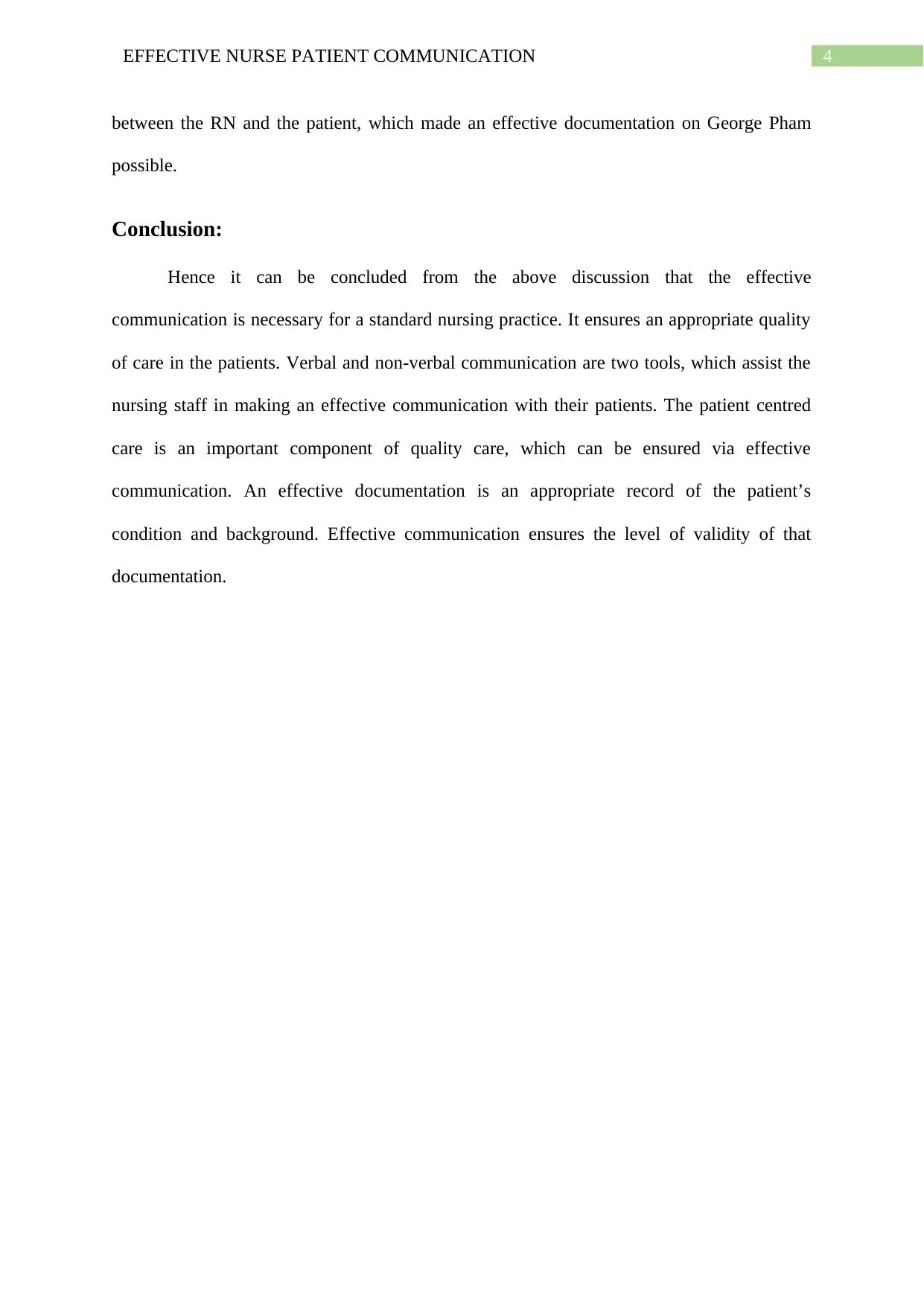
4EFFECTIVE NURSE PATIENT COMMUNICATION
between the RN and the patient, which made an effective documentation on George Pham
possible.
Conclusion:
Hence it can be concluded from the above discussion that the effective
communication is necessary for a standard nursing practice. It ensures an appropriate quality
of care in the patients. Verbal and non-verbal communication are two tools, which assist the
nursing staff in making an effective communication with their patients. The patient centred
care is an important component of quality care, which can be ensured via effective
communication. An effective documentation is an appropriate record of the patient’s
condition and background. Effective communication ensures the level of validity of that
documentation.
between the RN and the patient, which made an effective documentation on George Pham
possible.
Conclusion:
Hence it can be concluded from the above discussion that the effective
communication is necessary for a standard nursing practice. It ensures an appropriate quality
of care in the patients. Verbal and non-verbal communication are two tools, which assist the
nursing staff in making an effective communication with their patients. The patient centred
care is an important component of quality care, which can be ensured via effective
communication. An effective documentation is an appropriate record of the patient’s
condition and background. Effective communication ensures the level of validity of that
documentation.
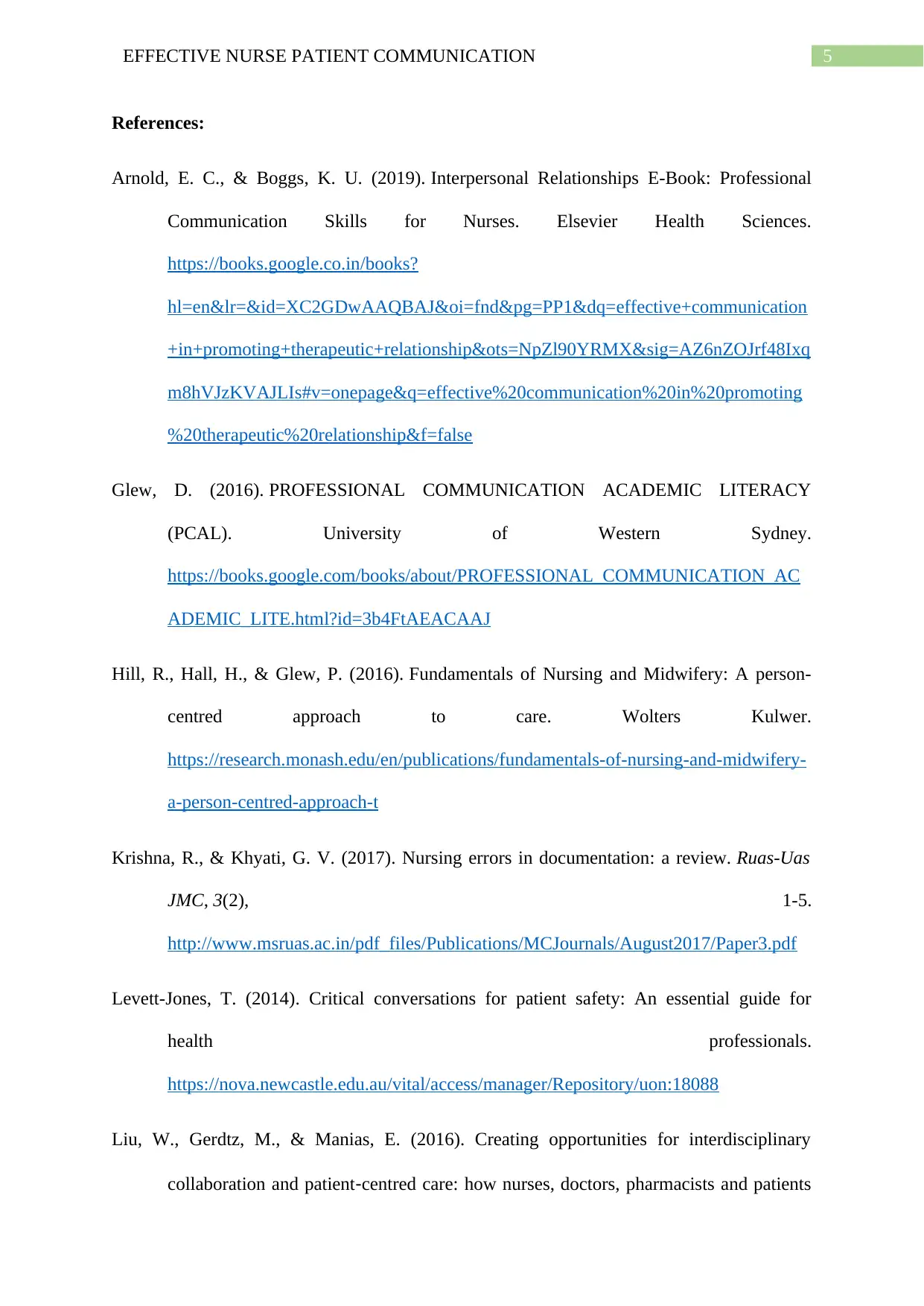
5EFFECTIVE NURSE PATIENT COMMUNICATION
References:
Arnold, E. C., & Boggs, K. U. (2019). Interpersonal Relationships E-Book: Professional
Communication Skills for Nurses. Elsevier Health Sciences.
https://books.google.co.in/books?
hl=en&lr=&id=XC2GDwAAQBAJ&oi=fnd&pg=PP1&dq=effective+communication
+in+promoting+therapeutic+relationship&ots=NpZl90YRMX&sig=AZ6nZOJrf48Ixq
m8hVJzKVAJLIs#v=onepage&q=effective%20communication%20in%20promoting
%20therapeutic%20relationship&f=false
Glew, D. (2016). PROFESSIONAL COMMUNICATION ACADEMIC LITERACY
(PCAL). University of Western Sydney.
https://books.google.com/books/about/PROFESSIONAL_COMMUNICATION_AC
ADEMIC_LITE.html?id=3b4FtAEACAAJ
Hill, R., Hall, H., & Glew, P. (2016). Fundamentals of Nursing and Midwifery: A person-
centred approach to care. Wolters Kulwer.
https://research.monash.edu/en/publications/fundamentals-of-nursing-and-midwifery-
a-person-centred-approach-t
Krishna, R., & Khyati, G. V. (2017). Nursing errors in documentation: a review. Ruas-Uas
JMC, 3(2), 1-5.
http://www.msruas.ac.in/pdf_files/Publications/MCJournals/August2017/Paper3.pdf
Levett-Jones, T. (2014). Critical conversations for patient safety: An essential guide for
health professionals.
https://nova.newcastle.edu.au/vital/access/manager/Repository/uon:18088
Liu, W., Gerdtz, M., & Manias, E. (2016). Creating opportunities for interdisciplinary
collaboration and patient‐centred care: how nurses, doctors, pharmacists and patients
References:
Arnold, E. C., & Boggs, K. U. (2019). Interpersonal Relationships E-Book: Professional
Communication Skills for Nurses. Elsevier Health Sciences.
https://books.google.co.in/books?
hl=en&lr=&id=XC2GDwAAQBAJ&oi=fnd&pg=PP1&dq=effective+communication
+in+promoting+therapeutic+relationship&ots=NpZl90YRMX&sig=AZ6nZOJrf48Ixq
m8hVJzKVAJLIs#v=onepage&q=effective%20communication%20in%20promoting
%20therapeutic%20relationship&f=false
Glew, D. (2016). PROFESSIONAL COMMUNICATION ACADEMIC LITERACY
(PCAL). University of Western Sydney.
https://books.google.com/books/about/PROFESSIONAL_COMMUNICATION_AC
ADEMIC_LITE.html?id=3b4FtAEACAAJ
Hill, R., Hall, H., & Glew, P. (2016). Fundamentals of Nursing and Midwifery: A person-
centred approach to care. Wolters Kulwer.
https://research.monash.edu/en/publications/fundamentals-of-nursing-and-midwifery-
a-person-centred-approach-t
Krishna, R., & Khyati, G. V. (2017). Nursing errors in documentation: a review. Ruas-Uas
JMC, 3(2), 1-5.
http://www.msruas.ac.in/pdf_files/Publications/MCJournals/August2017/Paper3.pdf
Levett-Jones, T. (2014). Critical conversations for patient safety: An essential guide for
health professionals.
https://nova.newcastle.edu.au/vital/access/manager/Repository/uon:18088
Liu, W., Gerdtz, M., & Manias, E. (2016). Creating opportunities for interdisciplinary
collaboration and patient‐centred care: how nurses, doctors, pharmacists and patients
⊘ This is a preview!⊘
Do you want full access?
Subscribe today to unlock all pages.

Trusted by 1+ million students worldwide
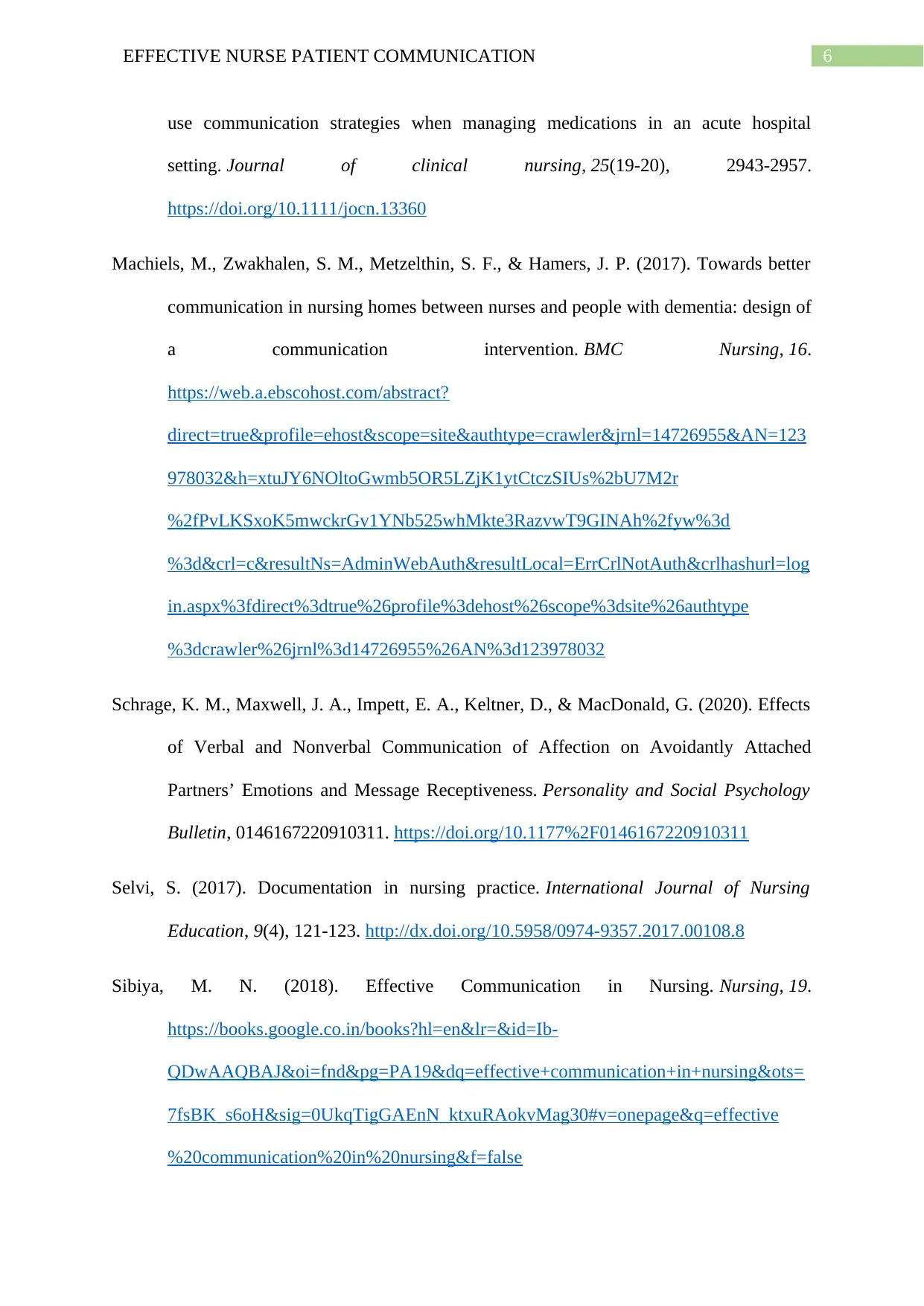
6EFFECTIVE NURSE PATIENT COMMUNICATION
use communication strategies when managing medications in an acute hospital
setting. Journal of clinical nursing, 25(19-20), 2943-2957.
https://doi.org/10.1111/jocn.13360
Machiels, M., Zwakhalen, S. M., Metzelthin, S. F., & Hamers, J. P. (2017). Towards better
communication in nursing homes between nurses and people with dementia: design of
a communication intervention. BMC Nursing, 16.
https://web.a.ebscohost.com/abstract?
direct=true&profile=ehost&scope=site&authtype=crawler&jrnl=14726955&AN=123
978032&h=xtuJY6NOltoGwmb5OR5LZjK1ytCtczSIUs%2bU7M2r
%2fPvLKSxoK5mwckrGv1YNb525whMkte3RazvwT9GINAh%2fyw%3d
%3d&crl=c&resultNs=AdminWebAuth&resultLocal=ErrCrlNotAuth&crlhashurl=log
in.aspx%3fdirect%3dtrue%26profile%3dehost%26scope%3dsite%26authtype
%3dcrawler%26jrnl%3d14726955%26AN%3d123978032
Schrage, K. M., Maxwell, J. A., Impett, E. A., Keltner, D., & MacDonald, G. (2020). Effects
of Verbal and Nonverbal Communication of Affection on Avoidantly Attached
Partners’ Emotions and Message Receptiveness. Personality and Social Psychology
Bulletin, 0146167220910311. https://doi.org/10.1177%2F0146167220910311
Selvi, S. (2017). Documentation in nursing practice. International Journal of Nursing
Education, 9(4), 121-123. http://dx.doi.org/10.5958/0974-9357.2017.00108.8
Sibiya, M. N. (2018). Effective Communication in Nursing. Nursing, 19.
https://books.google.co.in/books?hl=en&lr=&id=Ib-
QDwAAQBAJ&oi=fnd&pg=PA19&dq=effective+communication+in+nursing&ots=
7fsBK_s6oH&sig=0UkqTigGAEnN_ktxuRAokvMag30#v=onepage&q=effective
%20communication%20in%20nursing&f=false
use communication strategies when managing medications in an acute hospital
setting. Journal of clinical nursing, 25(19-20), 2943-2957.
https://doi.org/10.1111/jocn.13360
Machiels, M., Zwakhalen, S. M., Metzelthin, S. F., & Hamers, J. P. (2017). Towards better
communication in nursing homes between nurses and people with dementia: design of
a communication intervention. BMC Nursing, 16.
https://web.a.ebscohost.com/abstract?
direct=true&profile=ehost&scope=site&authtype=crawler&jrnl=14726955&AN=123
978032&h=xtuJY6NOltoGwmb5OR5LZjK1ytCtczSIUs%2bU7M2r
%2fPvLKSxoK5mwckrGv1YNb525whMkte3RazvwT9GINAh%2fyw%3d
%3d&crl=c&resultNs=AdminWebAuth&resultLocal=ErrCrlNotAuth&crlhashurl=log
in.aspx%3fdirect%3dtrue%26profile%3dehost%26scope%3dsite%26authtype
%3dcrawler%26jrnl%3d14726955%26AN%3d123978032
Schrage, K. M., Maxwell, J. A., Impett, E. A., Keltner, D., & MacDonald, G. (2020). Effects
of Verbal and Nonverbal Communication of Affection on Avoidantly Attached
Partners’ Emotions and Message Receptiveness. Personality and Social Psychology
Bulletin, 0146167220910311. https://doi.org/10.1177%2F0146167220910311
Selvi, S. (2017). Documentation in nursing practice. International Journal of Nursing
Education, 9(4), 121-123. http://dx.doi.org/10.5958/0974-9357.2017.00108.8
Sibiya, M. N. (2018). Effective Communication in Nursing. Nursing, 19.
https://books.google.co.in/books?hl=en&lr=&id=Ib-
QDwAAQBAJ&oi=fnd&pg=PA19&dq=effective+communication+in+nursing&ots=
7fsBK_s6oH&sig=0UkqTigGAEnN_ktxuRAokvMag30#v=onepage&q=effective
%20communication%20in%20nursing&f=false
Paraphrase This Document
Need a fresh take? Get an instant paraphrase of this document with our AI Paraphraser
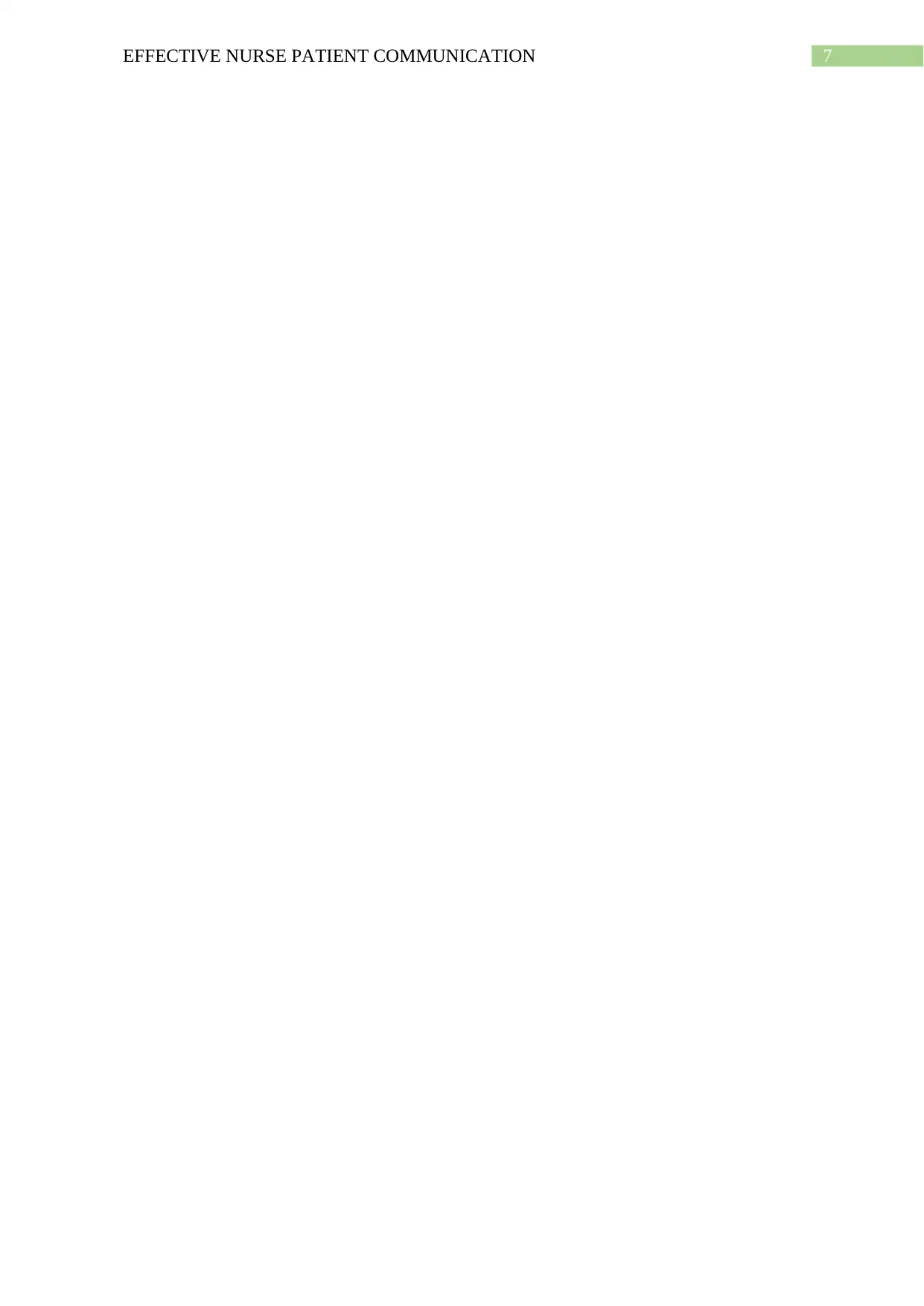
7EFFECTIVE NURSE PATIENT COMMUNICATION
1 out of 8
Related Documents
Your All-in-One AI-Powered Toolkit for Academic Success.
+13062052269
info@desklib.com
Available 24*7 on WhatsApp / Email
![[object Object]](/_next/static/media/star-bottom.7253800d.svg)
Unlock your academic potential
Copyright © 2020–2025 A2Z Services. All Rights Reserved. Developed and managed by ZUCOL.





